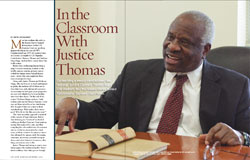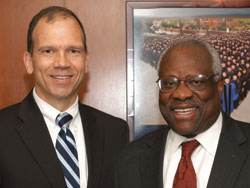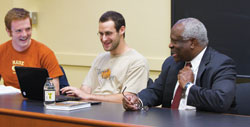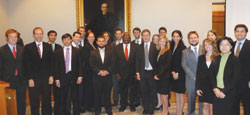In the Classroom With Justice Thomas
Co-teaching a weekly constitutional law seminar, Justice Clarence Thomas helps GW students find the hidden stories behind fundamental Supreme Court cases.

Justice Thomas became a familiar sight around the Law School during the fall semester, as he co-taught a seminar with his former clerk, Professor Maggs.
Most law students who refer to the lessons they've learned from justices on the U.S. Supreme Court are speaking figuratively. But in the case of GW's Constitutional Law 6399-14: Leading Cases in Context, co-taught by U.S. Supreme Court Justice Clarence Thomas and Professor Greg Maggs, students have a more direct line to the source.
Rather than synthesizing lessons from a judge's recorded summary, students in the weekly seminar examine primary sources to find the human stories behind famous cases—stories that can complicate those cases in unexpected ways.
Along with Justice Thomas and Professor Maggs, who say they are as much participants as guides, the students (all of whom are in their third year, with substantial experience in constitutional law) gain a new perspective on cases with which they've been familiar since their first classes. "At the end of the course," Professor Maggs explains, "each student picks another famous Supreme Court case and then writes his or her own history of it. So part of what our course is about is methodology: What makes these stories good? Why do we like this particular story?"
The class's novelistic approach is unusual in the context of legal education. Rather than following the "textbook" method of reading an abridged Supreme Court opinion, parsing that opinion for a rule, and then compiling the rules studied over the semester into an outline in preparation for a final exam, students examine the primary sources that informed the opinion itself. By reading transcripts, interviews, personal correspondence, and other historical documents, they bring cornerstone cases to life.
Justice Thomas isn't trying to start a revolution against the traditional model. "Don't knock outlines; that's what got me through [law school]!" he says with a laugh. But he's convinced that it takes more to make good lawyers. More important, in his view, are the values of thoroughness and humility that come from an exhaustive study of each case.
"I've been at this a long time," he says, "and nobody has the gospel on [any case]. You're always looking for answers. Even after all these years, you still want to dig behind these cases. And the longer you do it, the less you think you know about it. The less comfortable you are thinking, 'I have the answer.' That's where I am now, after being on the court for two decades."

Co-teaching the course reunited Justice Thomas and Professor Maggs; Professor Maggs clerked for both Justice Thomas and Justice Kennedy.

The justice's most prominent trait is certainly not a sense of his own consequence. "I did not expect how loosely Justice Thomas would wear his identity as a Supreme Court justice," says third-year student Harsh Voruganti, who says he senses that "[Justice Thomas'] identity as a Supreme Court justice is less important to him than is his identity as a Nebraska [football] fan."
"We're all learning this together," says Justice Thomas, who in person is genial, forthcoming, and contagiously enthusiastic about the class and the students he feels "privileged" to share it with. "I may know slightly more about the history of the cases, but what I'm really interested in is learning more about them. So [Professor Maggs] and I are learning it together, and we're learning it with the students."
Professor Maggs agrees—"and I wrote the textbook," he adds. "A lot of things that went on in these cases you wouldn't know, and couldn't know, just by reading the Supreme Court opinion. Until you get a much more complete, thorough history of the case, you just miss out on it."
"It's just that we get very comfortable with [famous cases] being stated a certain way" and standing for certain principles, Justice Thomas says, comparing the fact-finding process to the TV show Mythbusters.
In Plessy v. Ferguson, for example, the seminal case dealing with the segregation of railroad cars, students learned a number of perspective-changing facts by digging into the historical record: that it took some effort to bring the case in the first place, as the laws were unpopular with and rarely enforced by railroad companies, and that plaintiff Homer Plessy himself was "basically white," according to Justice Thomas. "That is, he had no features that were discernibly Negroid." His face lights up. "Isn't that fascinating?"
"Justice Thomas clearly really enjoys the class, specifically interacting with students," says class member Brittany Warren. "We all knew that we were going to have to really step up our game to take advantage of the opportunity—how often do you have a chance to engage a SCOTUS justice on the finer points of constitutional law—but I wasn't sure what to expect going into it. He has turned out to be incredibly warm and funny, and naturally, very insightful. When I gave my presentation on the case I'd chosen, he asked me questions drawn from some points I'd touched on only in footnotes. His enthusiasm for what we're trying to accomplish in the class really comes through."
"The best part of [teaching] is the students, watching them grow," says Justice Thomas. "I love that they're sincere about learning. I love watching them dig into cases and discover that their assumptions—that none of our assumptions—about the facts were necessarily right."
Justice Thomas' "willingness to engage with students as intellectual equals" is a major high point of the class, says Mr. Voruganti, who recalls having once suggested "that a law requiring students not to study more than six hours a day would be constitutional."
In response, he says, "Justice Thomas hit me with a series of hypotheticals regarding fundamental due process rights and asked me just how much deference I was willing to offer the legislature. After my rather garbled response, he graciously accepted my point as a good one and used it as a jumping-off point for the discussion. It's the closest I have gotten to being in an oral argument with a Supreme Court justice."

Justice Thomas hosted his class at the Supreme Court during the fall semester.
Students also find that delving into the personal histories behind the cases gives them more resonance.
"I personally was interested in [Korematsu v. United States, the case now widely known for having ruled that the Japanese internment camps of World War II were constitutional], because I wanted to know more about Asian-American history during that time," says Haixa Du, a part-time student who also holds a PhD in computer science. "I was amazed at how this case and its sister cases demonstrated the struggle of Japanese immigrants against discriminatory laws. Even as a Chinese immigrant who came to the United States long after the dust of these battles settled, I could still feel the frustration they experienced, and it made me more thankful to the friendlier United States I live in today."
What Justice Thomas tries most to communicate to students is that they should bring "humility" to the art of lawyering. "You've got to approach the law with a sense of modesty, and with thoroughness," he says.
That notion of care and completeness is something the justice values outside the classroom as well. "All we're asking you to do is to look at [cases] honestly and thoroughly, so you have a full understanding of them," he says. "The rule I have with my law clerks is that they will leave their job with clean hearts, clean hands, and clean consciences. Because we're going to do things in a way that we think is [thorough.] Does that make us perfect? No. But there's no moral turpitude to [making] mistakes. That's just human imperfection."
Professor Maggs recalls a telling early conversation regarding the very premise of the class. "One of the students said, 'I'm not clear on the theory of why you'd always want to know more facts. What does it really get you?' And Justice Thomas' answer, which I think was pretty good, was 'Why would you want to know less?'"
"You always want to learn more," the justice says. "Look, if you don't know it all now, if you can't get all the ends tied up, that's a part of the wonderful process." He smiles. "Keep digging."
